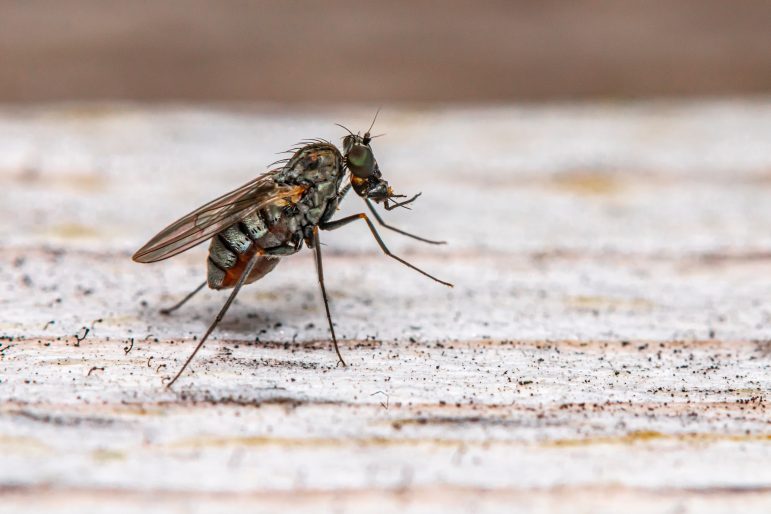Washroom care is critical to creating a favourable impression of any establishment. Patrons expect facilities to always be in sanitary and working order, which means routine vigilance must be taken in these delicate areas. Hopefully, washroom pests are the last thing on your guests’ mind, but that’s only possible if pest management remains top of mind for management and staff.
Use these tips below as guidelines to help you create an action plan for the prevention of washroom pests.
Know which pests to look out for
Pests are often drawn to washrooms because of odours, trash, moisture and the shelter they can provide. While every facility is different, the most common offenders are cockroaches, psocids, centipedes, rodents and small flies.
- Cockroaches can measure over 50 millimetres in length, have six legs, two antennae, and some species have wings. Certain types are more indoor pests and can hide in very small spaces, hitching rides on things like backpacks or briefcases.
- Psocids. There are over 200 species of psocids, most of which are tiny insects. Their size ranges from 1 to 6 millimetres, and colour varies among species. They like to inhabit warm, moist places. They feed on mould or fungi and are common in humid habitats and poorly ventilated areas. Damp paper products or cardboard boxes, moulded wood, leaking sinks, and cracks and crevices in baseboards and walls are large attractants.
- Centipedes can have several different colours and patterns, range in size from 4 to 152 millimetres, and can have anywhere from 15 to 177 pairs of legs. The most common indoor centipede is the common house centipede, brown and reddish-orange in colour and 25 to 40 millimetres long. Centipedes cannot survive in the cold, so they often move inside through pipes, drains, or cracks in walls to avoid harsh winters and prey indoors. When temperatures are cold outside, you can likely find them in washrooms. They seek out moisture, so maintaining humidity, ensuring wet areas are dried frequently, and thoroughly closing off any cracks and crevices or unscreened vents are the best deterrents.
- There are many different types of rodents that could be offenders here, from mice to rats. Rodents squeeze through small openings and lap up small puddles of water – both of which washrooms can have.
- Small flies. Small species such as phorid flies, drain flies, and fungus gnats, are all common in washrooms. Phorid flies breed at the base of toilets if not properly sealed (resulting in pipe condensation that attracts them), and are also attracted to poorly maintained drains, both at sinks and in the floor. Drain flies will breed in drains as well, and fungus gnats like potted plants or moist organic matter that can collect in cracks and crevices on restroom floors.
Keep an eye on pest hidings spots
Have cleaning staff regularly check these spots for pests or signs of pest activity – ideally every time they clean – so you will know as soon as possible when signs of pest activity, such as sightings, droppings or chew marks, have begun.
- Always make sure plumbing seals are tight and not leaking.
- Trash receptacles. Look around, in, and behind all trash receptacles – including ones mounted on the inside walls of stalls – as waste buildup attracts rodents and provides a soft hiding spot.
- As a space that can often be neglected when cleaning, be sure staff pays proper attention to cleaning closets as often as they do the rest of the washrooms to avoid pests hunkering down.
- Ceilings and light fixtures. Ceilings, especially those with removable foam tiles, and light fixtures are common hiding spots for pests. Be sure staff regularly checks light fixtures for any debris inside them, as these are often pests, and make sure regular ceiling maintenance is scheduled and kept to.
Keep up with sanitation and maintenance
Regular, preventive tasks, in addition to monitoring, is one of the best ways to not only keep pests out but also keep your restroom clean – as these can often go hand-in-hand.
- Maintain toilets. Unclean toilets can produce odours that attract pests. Automatic flushing mechanisms can reduce build-up as well as the spread of germs through physical contact. Toilet bases can also wear out over time, so ensure they are inspected regularly to make sure there is a proper seal and avoid a source of odour as well as a breeding medium for small flies.
- Regularly clean floors. If not cleaned properly and regularly, dirty floors and drains can cause issues with odours, buildup of decaying organic material, and trash. Wide tile grouts serve as wells, retaining water and sediments of debris that provide a fly breeding ground – ensure gaps between tile are properly caulked and dried. When mopping, make sure water is clean to avoid the risk of transferring dirt and bacteria from surface to surface.
- Inspect sinks and faucets. Fix any broken or leaky sinks and faucets, as well as regularly sanitizing the area. Ensuring sinks and faucets are properly caulked is crucial, as gaps can trap moisture that attracts pests. Inspect these areas regularly and reseal whenever necessary.
- Take out the trash often. Trash offers shelter and food for many pests – rounding out the trifecta of what a pest needs to survive (food, water, and shelter). Ideally, trash should be emptied daily and always kept in a bin with a liner and a lid that stays closed. Under liners should always be cleaned and dried before re-lining bins, and occasionally the bottom of receptacles should be cleaned as well.
- Eliminate foul odours. As a good sanitation practice, odours should always be dealt with at the source and never just masked. Strict sanitation practices all around washrooms can help here. Utilize odour-neutralizing products to break down odour molecules and eliminate airborne odours.
- Properly ventilate. Ensure proper ventilation and illumination in washrooms, as this reduces the suitable breeding conditions for many of the problematic restroom pests.
- Maintain potted plants. If your restroom has potted plants, regularly check for fungus gnats. Do not overwater plants, and make sure soil dries in between watering to avoid too much moisture buildup. Do not let dead leaves accumulate on top of the soil, as this offers a great breeding ground for small flies.
Keep in mind the specific needs of your facility. For example, older buildings are notoriously more susceptible to pest issues than newer buildings, as they tend to have more cracks and crevices for pests to wriggle through. Public washrooms in high-traffic areas, like in schools or universities, are highly susceptible to pest issues.
Make sure to incorporate these methods into your current sanitation and maintenance plans as a holistic approach to restroom care. Executing on a well-developed plan is the best way to keep your restroom pest-free between your regularly scheduled pest management visits. Should you come across signs of any pest activity, contact your pest management provider immediately to assess and help rectify the issue.
Alice Sinia, Ph.D. is quality assurance manager of regulatory/lab Services for Orkin Canada focusing on government regulations pertaining to the pest control industry. With more than 20 years of experience, she manages the quality assurance laboratory for Orkin Canada and performs analytical entomology as well as provides technical support in pest/insect identification to branch offices and clients. For more information, email Alice Sinia at asinia@orkincanada.com or visit www.orkincanada.com.









